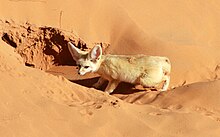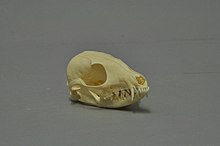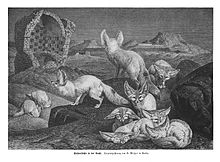Fennec fox
| Fennec fox | |
|---|---|
 | |
| Fennec fox in the Moroccan Sahara | |
| Scientific classification | |
| Domain: | Eukaryota |
| Kingdom: | Animalia |
| Phylum: | Chordata |
| Class: | Mammalia |
| Order: | Carnivora |
| Infraorder: | Cynoidea |
| Family: | Canidae |
| Subfamily: | Caninae |
| Tribe: | Vulpini |
| Genus: | Vulpes |
| Species: | V. zerda |
| Binomial name | |
| Vulpes zerda (Zimmermann, 1780) | |
 | |
| Fennec range | |
The fennec fox (Vulpes zerda) is a small crepuscular fox native to the deserts of North Africa, ranging from Western Sahara and Mauritania to the Sinai Peninsula.[1] Its most distinctive feature is its unusually large ears, which serve to dissipate heat and listen for underground prey. The fennec is the smallest fox species. Its coat, ears, and kidney functions have adapted to the desert environment with high temperatures and little water. It mainly eats insects, small mammals and birds. The fennec has a life span of up to 14 years in captivity and about 10 years in the wild. Its main predators are the Verreaux's eagle-owl, jackals and other large mammals. Fennec families dig out burrows in the sand for habitation and protection, which can be as large as 120 m2 (1,300 sq ft) and adjoin the burrows of other families. Precise population figures are not known but are estimated from the frequency of sightings; these indicate that the fennec is currently not threatened by extinction. Knowledge of social interactions is limited to information gathered from captive animals. The fennec's fur is prized by the indigenous peoples of North Africa, and it is considered an exotic pet in some parts of the world.
Its name comes from the species' Arabic name: fanak (فَنَك).[2]
Description

The fennec fox has sand-colored fur which reflects sunlight during the day and helps keep it warm at night. Its nose is black and its tapering tail has a black tip. Its long ears have longitudinal reddish stripes on the back and are so densely haired inside that the external auditory meatus is not visible.[3] The edges of the ears are whitish, but darker on the back. The ear to body ratio is the greatest in the canid family and likely helps in dissipating heat and locating vertebrates. It has dark streaks running from the inner eye to either side of the slender muzzle. Its large eyes are dark. The dental formula is 3.1.4.23.1.4.3 × 2 = 42 with small and narrow canines. The pads of its paws are covered with dense fur, which facilitates walking on hot, sandy soil.[4]
The fennec fox is the smallest canid species. Females range in head-to-body size from 34.5 to 39.5 cm (13.6 to 15.6 in) with a 23–25 cm (9.1–9.8 in) long tail and 9–9.5 cm (3.5–3.7 in) long ears, and weigh 1–1.9 kg (2.2–4.2 lb). Males are slightly larger, ranging in head-to-body size from 39 to 39.5 cm (15.4 to 15.6 in) with a 23–25 cm (9.1–9.8 in) long tail and 10 cm (3.9 in) long ears, weighing at least 1.3 kg (2.9 lb).[4]
Distribution and habitat
The fennec fox is distributed throughout the Sahara, from Morocco and Mauritania to northern Sudan, through Egypt and its Sinai Peninsula.[1] It inhabits small sand dunes and vast treeless sand areas with sparse vegetation such as grasses, sedges and small shrubs.[4][5]
Behaviour and ecology

Fennec foxes are primarily nocturnal, displaying heightened activity during the cooler nighttime hours.[6] This behaviour helps them escape the extreme Saharan heat and reduces water loss through panting.[7] A fennec fox digs its den in sand, either in open areas or places sheltered by plants with stable sand dunes. In compacted soils, dens are up to 120 m2 (1,300 sq ft) large, with up to 15 different entrances. In some cases, different families interconnect their dens, or locate them close together. In soft, looser sand, dens tend to be simpler with only one entrance leading to a single chamber.[4]
Captive individuals reside in family groups consisting of several members. Fennec foxes exhibit playful behavior, especially among younger individuals.[8]
Hunting and diet
The fennec fox is omnivorous, feeding on small rodents, lizards (geckos and skinks), small birds and their eggs, insects, fruits, leaves, roots and also some tubers.[9] It relies on the moisture content of prey, but drinks water when available.[4] It hunts alone and digs in the sand for small vertebrates and insects. Some individuals were observed to bury prey for later consumption and searching for food in the vicinity of human settlements.[10]
In the Algerian Sahara, 114 scat samples were collected that contained more than 400 insects, plant fragments and date palm (Phoenix dactylifera) fruits, remains of birds, mammals, squamata and insects.[11]
Reproduction

Fennec foxes mate for life.[12] Captive fennec foxes reach sexual maturity at around nine months and mate between January and April.[13][14] Female fennec foxes are in estrus for an average of 24 hours and usually breed once per year; the copulation tie lasts up to two hours and 45 minutes.[15] Gestation usually lasts between 50 and 52 days, though sometimes up to 63 days.[16][17] After mating, the male becomes very aggressive and protects the female, and provides her with food during pregnancy and lactation.[18] Females give birth between March and June to a litter of one to four pups that open their eyes after 8 to 11 days.[17][14] Both female and male care for the pups. They communicate by barking, purring, yapping and squeaking. Pups remain in the family even after a new litter is born.[13] The pups are weaned at the age of 61 to 70 days.[19] Adults rear pups until they are around 16 to 17 weeks old.[12] The oldest captive male fennec fox was 14 years old, and the oldest female 13 years.[4]
Diseases
Captive fennec foxes are susceptible to canine distemper virus, displaying fever, mucopurulent ocular discharge, diarrhea, severe emaciation, seizures, generalized ataxia, severe dehydration, brain congestion, gastric ulcers and death. Stress because of capture and long-distance transportation are thought to be the causes.[20]
Predators
African horned owl species such as the Pharaoh eagle-owl prey on fennec fox pups. Anecdotal reports exist about caracals, jackals, and striped hyenas also preying on the fennec fox. But according to nomads, the fennec fox is fast and changes directions so well that even their Salukis are hardly ever able to capture it.[4]
Threats
In North Africa, the fennec fox is commonly trapped for exhibition or sale to tourists. Expansion of permanent human settlements in southern Morocco caused its disappearance in these areas and restricted it to marginal areas.[1]
Conservation
As of 2015, the fennec fox is classified as Least concern on the IUCN Red List.[1] It is listed in CITES Appendix II and is protected in Morocco and Western Sahara, Algeria, Tunisia and Egypt, where it has been documented in several protected areas.[1]
In captivity
The fennec fox is bred commercially as an exotic pet.[10] Commercial breeders remove the pups from their mother to hand-raise them, as tame foxes are more valuable. A breeders' registry has been set up in the United States to avoid any problems associated with inbreeding.[21]
In culture

The fennec fox is the national animal of Algeria.[22] It also serves as the nickname for the Algeria national football team "Les Fennecs".[23]
References
- ^ a b c d e f g Wacher, T.; Bauman, K. & Cuzin, F. (2015). "Vulpes zerda". IUCN Red List of Threatened Species. 2015: e.T41588A46173447. doi:10.2305/IUCN.UK.2015-4.RLTS.T41588A46173447.en. Retrieved 19 November 2021.
- ^ "fennec". Merriam-Webster. Retrieved 30 January 2020.
- ^ Zimmermann, E.A.W. (1780). "Der Zerda". Geographische Geschichte des Menschen, und der allgemein verbreiteten vierfüßigen Thiere. Vol. II. Enthält ein vollständiges Verzeichniß aller bekannten Quadrupeden. Leipzig: Weygand. pp. 247–248.
- ^ a b c d e f g Asa, C.S.; Valdespino, C. & Cuzin, F. (2004). "Fennec fox Vulpes zerda (Zimmermann, 1780)" (PDF). In Sillero-Zubiri, C.; Hoffman, M. & Mech, D. (eds.). Canids: Foxes, Wolves, Jackals and Dogs: Status Survey and Conservation Action Plan. Gland, Switzerland: IUCN/SSC Canid Specialist Group. pp. 205–209. ISBN 2-8317-0786-2.
- ^ Karssene, Y.; Chammem, M.; Li, F.; Eddine, A.; Hermann, A. & Nouira, S. (2019). "Spatial and temporal variability in the distribution, daily activity and diet of fennec fox (Vulpes zerda), red fox (Vulpes vulpes) and African golden wolf (Canis anthus) in southern Tunisia". Mammalian Biology. 95 (1): 41–50. doi:10.1016/j.mambio.2019.02.001. S2CID 91615641.
- ^ Carlstead, K. (1990). "Husbandry of the Fennec fox: Fennecus zerda: environmental conditions influencing stereotypic behaviour". International Zoo Yearbook. 30 (1): 202. doi:10.1111/j.1748-1090.1990.tb01164.x.
- ^ Maloiy, G. M. O.; Kamau, J. M. Z.; Shkolnik, A.; Meir, M.; Arieli, R. (1982). "Thermoregulation and metabolism in a small desert carnivore: the Fennec fox (Fennecus zerda) (Mammalia)". Journal of Zoology. 198 (3): 279–291. doi:10.1111/j.1469-7998.1982.tb02076.x.
- ^ Dempsey, J. L.; Hanna, S. J.; Asa, C. S.; Bauman, K. L. (2009). "Nutrition and behavior of Fennec Foxes (Vulpes zerda)". Veterinary Clinics of North America: Exotic Animal Practice. Nutrition and Behavior of Uncommon Species. 12 (2): 299–312. doi:10.1016/j.cvex.2009.01.004.
- ^ "Vulpes zerda (Fennec)". Animal Diversity Web.
- ^ a b Asa, C.S. & Cuzin, F.A. (2013). "Vulpes zerda Fennec Fox". In Kingdon, J.; Happold, D.; Hoffmann, M.; Butynski, T.; Happold, M. & Kalina, J. (eds.). Mammals of Africa. Vol. V: Carnivores, Pangolins, Equids and Rhinoceroses. London, New Delhi, New York, Sydney: Bloomsbury. pp. 74–77. ISBN 978-1-4081-8994-8.
- ^ Brahmi, K.; Khechekhouche, E.A.; Mostefaoui, O.; Doumandji, S.; Baziz, B. & Aulagnier, S. (2012). "First quantitative data on the diet of the fennec fox, Vulpes zerda (Canidae, Carnivora), in Algeria". Folia Zoologica. 61: 61–70. doi:10.25225/fozo.v61.i1.a10.2012. S2CID 86211731.
- ^ a b Siciliano-Martina, L.; Martina, J. P.; Dohnalik, E.; Vielleux, G. (2023). "Factors influencing the timing and frequency of litters in captive fennec foxes (Vulpes zerda)". Animal Reproduction Science. 248: 107182. doi:10.1016/j.anireprosci.2022.107182.
- ^ a b Gauthier-Pilters, H. (1967). "The Fennec". African Wildlife. 21: 117–125.
- ^ a b Saint Girons, M. C. (1962). "Notes sur les dates de reproduction en captivite du fennec, Fennecus zerda (Zimmerman, 1780)" (PDF). Zeitschrift für Säugetierkunde (in French). 27: 181–184.
- ^ Valdespino, C.; Asa, C. S. & Bauman, J. E. (2002). "Estrous cycles, copulation and pregnancy in the fennec fox (Vulpes zerda)" (PDF). Journal of Mammalogy. 83 (1): 99–109. doi:10.1644/1545-1542(2002)083<0099:ECCAPI>2.0.CO;2. S2CID 51812228.
- ^ Petter, F. (1957). "La reproduction du fennec". Mammalia. 21: 307–309.
- ^ a b Gangloff, L. (1972). "Breeding fennec foxes Fennecus zerda at Strasbourg Zoo". International Zoo Yearbook. 12 (1): 115–116. doi:10.1111/j.1748-1090.1972.tb02289.x.
- ^ Sowards, R. K. (1981). "Observation on breeding and rearing the fennec fox (Fennecus zerda) in captivity". Animal Keepers' Forum. 8: 175–177.
- ^ Koenig, L. (1970). "Zur Fortpflanzung und Jungendentwicklung des Wüstenfuchses (Fennecus zerda Zimm. 1780)". Zeitschrift für Tierpsychologie (in German). 27 (2): 205–246. doi:10.1111/j.1439-0310.1970.tb01873.x. S2CID 84068292.
- ^ Woo, G.-H.; Jho, Y.-S.; Bak, E.-J. (2010). "Canine distemper virus infection in Fennec Fox (Vulpes zerda)". Journal of Veterinary Medical Science. 72 (8): 1075–1079. doi:10.1292/jvms.09-0510. PMID 20299771.
- ^ Roots, C. (2007). Domestication. Westport: Greenwood. pp. 113–114. ISBN 978-0-313-33987-5.
- ^ Hodges, K. (2012). "National Animals of African Countries". Archived from the original on 25 February 2014. Retrieved 19 February 2014.
- ^ Fifa (2009). "Paris salutes Les Fennecs". Fifa. Archived from the original on 1 June 2010.
External links
 Data related to Fennec fox at Wikispecies
Data related to Fennec fox at Wikispecies Media related to Vulpes zerda at Wikimedia Commons
Media related to Vulpes zerda at Wikimedia Commons


 French
French Deutsch
Deutsch
